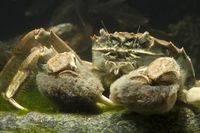Difference between revisions of "Pollution and scavengers"
| Line 6: | Line 6: | ||
Therefore, decomposers tend to have higher pollutant contents than other [[pollution and zoobenthos|zoobenthos]]. This although they both (unlike [[pollution and marine mammals|marine mammals]] and [[pollution and sea birds|sea birds]]) also acquire a large part of their pollutants through direct contact with the water; while acquiring oxygen from the water, pollutants can be [[adsorption|adsorbed]] as well. | Therefore, decomposers tend to have higher pollutant contents than other [[pollution and zoobenthos|zoobenthos]]. This although they both (unlike [[pollution and marine mammals|marine mammals]] and [[pollution and sea birds|sea birds]]) also acquire a large part of their pollutants through direct contact with the water; while acquiring oxygen from the water, pollutants can be [[adsorption|adsorbed]] as well. | ||
| − | Crabs, especially their larvae, appear to be vulnerable to pesticides<ref>Levinton, J.S. (2001). Marine biology: function, biodiversity, ecology. 2nd Edition. Oxford University Press: New York, NY (USA). ISBN 0-19-514172-5. xi, 515, col. pl. pp.</ref>, which resulted | + | Crabs, especially their larvae, appear to be vulnerable to pesticides<ref>Levinton, J.S. (2001). Marine biology: function, biodiversity, ecology. 2nd Edition. Oxford University Press: New York, NY (USA). ISBN 0-19-514172-5. xi, 515, col. pl. pp.</ref>, which resulted during the 1960s in the collapse of the Chesapeake Bay crab fishery, due to a pesticide called keptone. |
Below you can find some links to Belgian case studies on ecotoxicology in marine scavengers. | Below you can find some links to Belgian case studies on ecotoxicology in marine scavengers. | ||
Revision as of 07:47, 23 September 2009
Decomposers typically live on the sea floor and include species like crabs, hermit crabs, whelks and starfish.[1] They feed primary on decaying organic matter, which can often contain high concentrations of pollutants. [2] Therefore, decomposers tend to have higher pollutant contents than other zoobenthos. This although they both (unlike marine mammals and sea birds) also acquire a large part of their pollutants through direct contact with the water; while acquiring oxygen from the water, pollutants can be adsorbed as well.
Crabs, especially their larvae, appear to be vulnerable to pesticides[3], which resulted during the 1960s in the collapse of the Chesapeake Bay crab fishery, due to a pesticide called keptone.
Below you can find some links to Belgian case studies on ecotoxicology in marine scavengers.
Case studies
Case study 1: Flame retardants organotin compounds and surfactants in opossum shrimps of the Scheldt estuary.[4]
Case study 2: Effects of endocrine disrupting compounds on embryonic development of opossum shrimps.[5]
Case study 3: Common starfish can act as a bioindicator for heavy metal pollution[6]
References
- ↑ Moore P.G., Howarth J., 1996 Foraging by marine scavengers: Effects of relatedness, bait damage and hunger. Journal of Sea Research, Volume 36, Issues 3-4, P. 267-273
- ↑ Voorspoels, S.; Covaci, A.; Maervoet, J.; De Meester, I.; Schepens, P. (2004). Levels and profiles of PCBs and OCPs in marine benthic species from the Belgian North Sea and the Western Scheldt Estuary. Mar. Pollut. Bull. 49(5-6): 393-404
- ↑ Levinton, J.S. (2001). Marine biology: function, biodiversity, ecology. 2nd Edition. Oxford University Press: New York, NY (USA). ISBN 0-19-514172-5. xi, 515, col. pl. pp.
- ↑ Verslycke, T.; Vethaak, A.D.; Arijs, K.; Janssen, C.R. (2004). Flame retardants, surfactants and organotins in sediment and mysid shrimp of the Scheldt estuary (The Netherlands). Environ. Poll. 136(1): 19-31
- ↑ Ghekiere, A.; Fockedey, N.; Verslycke, T.; Vincx, M.; Janssen, C.R. (2007). Marsupial development in the mysid Neomysis integer (Crustacea: Mysidacea) to evaluate the effects of endocrine-disrupting chemicals. Ecotoxicol. Environ. Saf. 66(1): 9-15
- ↑ Temara, A.; Skei, J.M.; Gillan, D.; Warnau, M.; Jangoux, M.; Dubois, Ph. (1998). Validation of the asteroid Asterias rubens (Echinodermata) as a bioindicator of spatial and temporal trends of Pb, Cd, and Zn contamination in the field. Mar. Environ. Res. 45(4-5): 341-356
